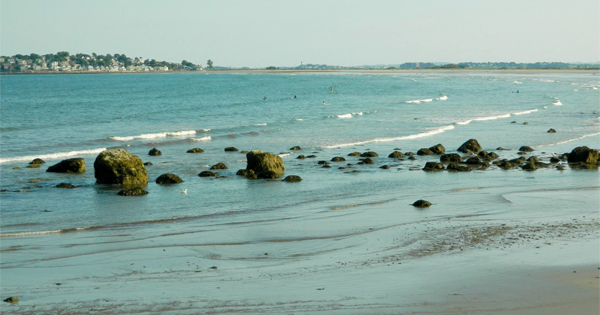
Work is ongoing to target potential sources and solutions for the issues forcing the frequent closing of King’s Beach due to elevated bacteria levels.
In recent weeks, closed-circuit cameras were temporarily placed inside 21 miles of storm drains for inspection and cleaning.
“Most of these pipes were installed in the late ’90s or early 2000s, so cleaning wasn’t excessive,” said Lynn Water and Sewer Commission Executive Director Daniel O’Neill. “We put the camera through, cleaned it and took out anything that shouldn’t be there. It’s kind of like a colonoscopy for the pipes.”
O’Neill said they were able to pull out five small connections between people’s sewer drains and the beach, but they didn’t uncover “any glaring issues.”
Prior to 1985, when Lynn’s $65 million wastewater treatment facility opened, sewer pipes and storm drains were connected to Stacey’s Brook, which emptied into King’s Beach. That is no longer the case, but the city is doing its due diligence to make sure no other sewer-to-pipe connections were missed.
“We’re pursuing treatment options, but source elimination is still the main priority right now,” said O’Neill.
The commission has been working with Environmental Partners, an environmental engineering consulting firm. Consultants from the firm have been addressing infrastructure improvements to the city’s sewage and storm drain system.
The beach has continuously been an area of focus for state and federal agencies, Lynn and Swampscott officials, and nonprofits such as Save the Harbor/Save the Bay and Friends of Lynn & Nahant Beach. Kleinfelder, a company of engineers, scientists and construction professionals who provide solutions to improve water, energy and other infrastructure, has been working for the Town of Swampscott on the King’s Beach Water Quality Engineering Study, which identifies and analyzes alternative approaches to alleviate the water quality issues. The company is receiving technical assistance from both the U.S. Environmental Protection Agency (EPA) and the Department of Environmental Protection (DEP). The EPA and DEP agree that Lynn is doing everything it should be doing to identify and eliminate illicit discharges, O’Neill said. While extending the outfall deeper into the ocean may be a long-term solution, a possible short-term improvement could be disinfection with ultraviolet light.
“The state of King’s Beach is entirely unacceptable and we’re doing everything we can to work with the many stakeholders to fix it, which includes repairing the sewer pipes and identifying illicit connections,” said Mayor Jared C. Nicholson. “According to our environmental regulators, that is proceeding as quickly as possible in Lynn given that the pipes are relatively new and we’re looking for hard-to-find missed connections. We are also exploring complementary solutions such as ultraviolet technology, which according to our environmental regulators will be necessary even once the pipes are fixed to keep the beach open an acceptable amount of time.”
“For far too long it has been unsafe for families to swim at King’s Beach. While we have made significant progress in recent years, we share the frustration and sense of urgency that our community collectively feels,” said Sen. Brendan Crighton. “We will continue to work tirelessly and collaboratively to take every possible action to correct this environmental injustice.”
Crighton noted that the state delegation secured $5 million dollars in ARPA funding – one of the biggest earmarks across the state that came from ARPA – to help with the King’s Beach clean-up, funding that was directed to Lynn and Swampscott for that purpose.
“Swampscott continues to work closely with the City of Lynn to advance a more aggressive IDDE effort to address the impairments to Kings Beach,” said Swampscott Town Administrator Sean Fitzgerald. “The Town has outlined a plan to invest $7 million over the next two years to dramatically enhance the work to mitigate sewage infiltrating into the drainage pipes that lead to Kings Beach. We need our state and federal partners to help find additional funding to protect the health and safety of our region and our Commonwealth.”
The water quality at King’s Beach is currently tested daily and an interactive data dashboard provides results at mass.gov. Daily samples are collected at three sites on the beach: Kimball Road, Pierce Street, and Eastern Avenue in Lynn. A weekly sample is collected at one location in Swampscott, which is managed separately by the Town of Swampscott, not by the Department of Conservation and Recreation (DCR). Stacey’s Brook generally has the highest levels of bacteria, and beachgoers are advised not to swim or wade in the brook. On the beach itself, the DCR posts daily flags for “safe to swim” (blue) and “not safe to swim” (red).
Beach flag PSA
This PSA was created by 2024 LifeScene extern Nathanael Henri.
The above press release was submitted to us by Mayor Nicholson’s office.
If you have a news story that you would like to share, please contact us via email or call 781-780-9460.

